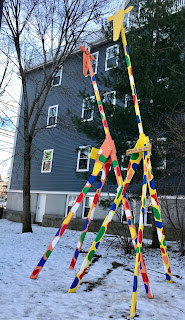Day 38 – Community Arts: Somerville and Watertown

Day 38 - Today was my first time walking on the Somerville Community Path near Davis Square. Not only was it a great place to walk and people watch but the artwork that lives along the path was quirky, delightful, and inspiring. There were the giant giraffes, birdhouses, a collection of fairy houses, and a scrap sculpture garden. I tried to find out who had made the sculptures, but I couldn’t find out. One of the best parts of the sculptures, is that they are interactive – by pulling on a lever you can make the giraffe’s ears wiggle! I was entranced, delighted, and surprised by these various collections – it was clear that there were not done by one person, but by a “community!” And I thought – I want to be able to walk here all the time!! It reminded me of a project near my home – the Yard Art Watertown project. I walk past a collage sculpture right in front of a neighbor’s house every time I walk the dog, and it’s so quirky and fun that I feel inspired to make c

.jpg)







